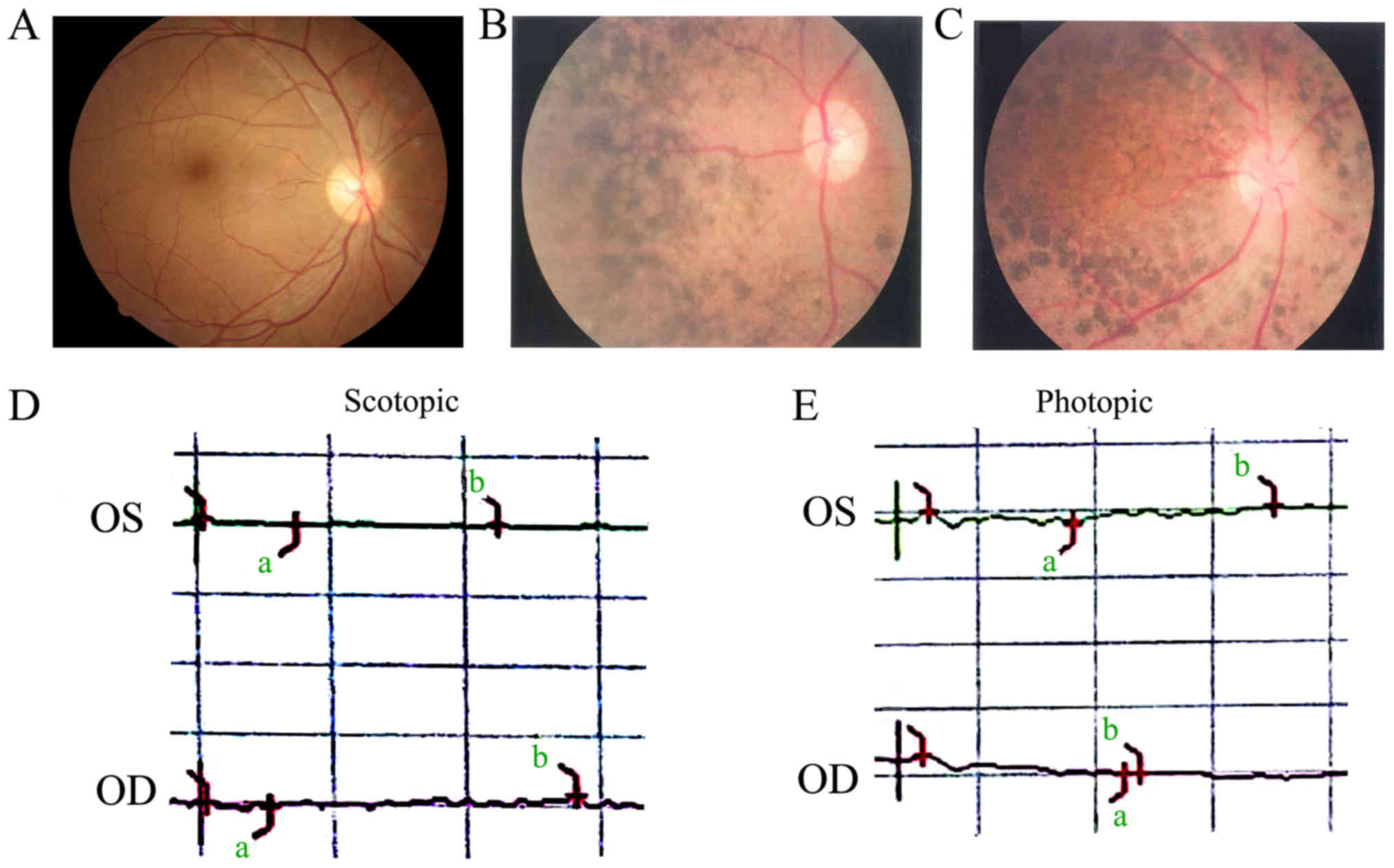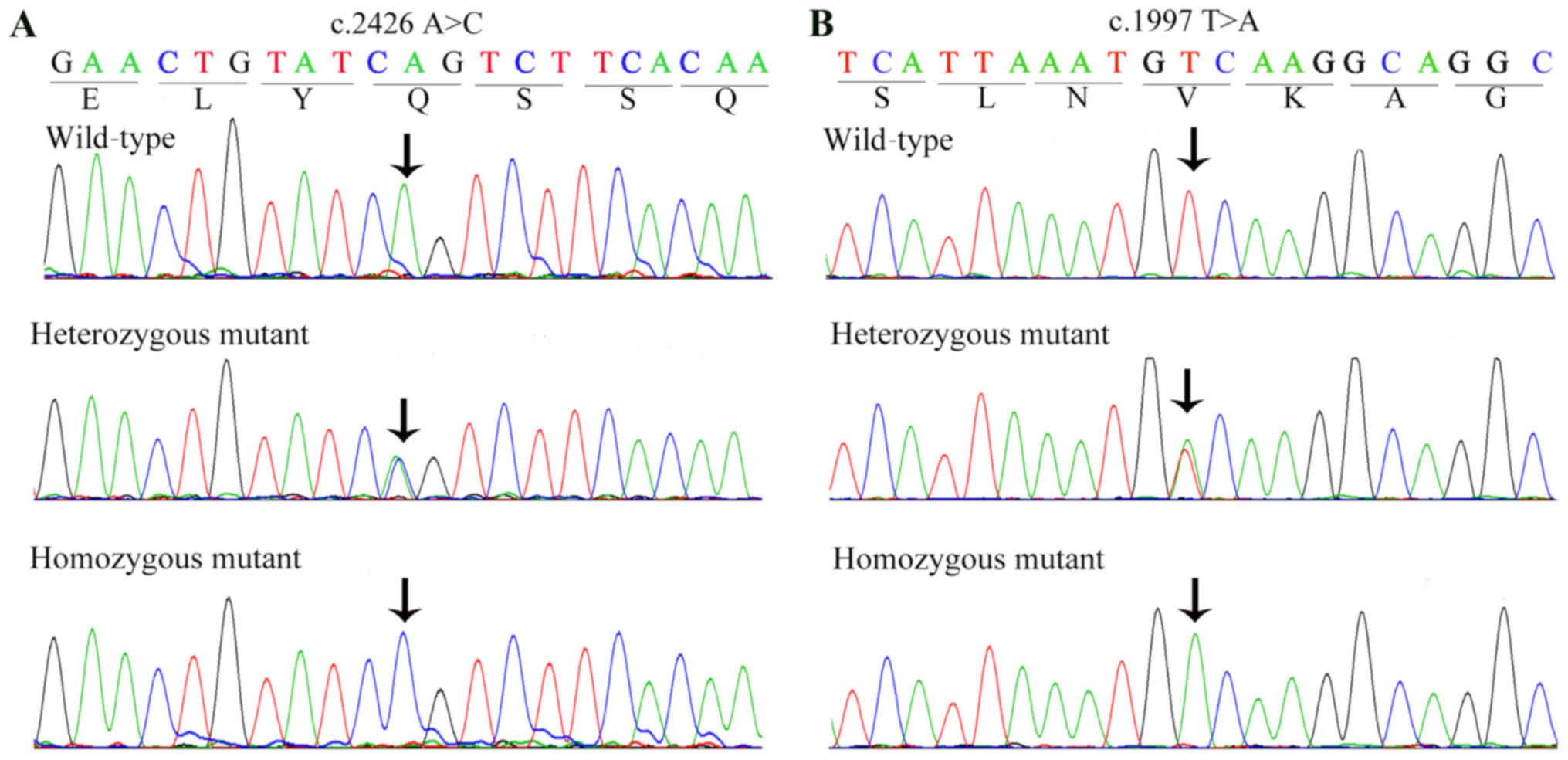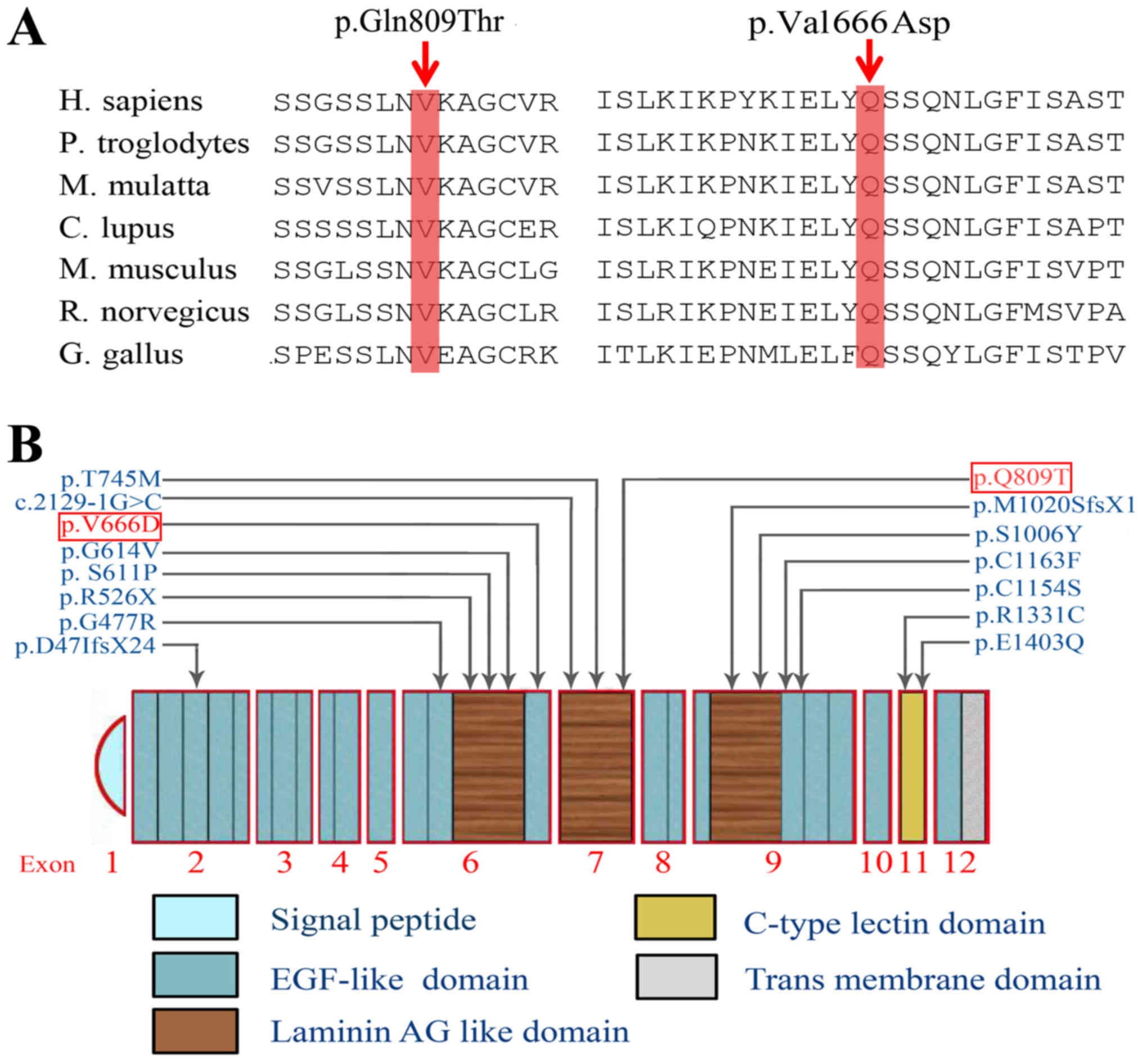|
1
|
Bird AC: Retinal photoreceptor dystrophies
LI. Edward Jackson Memorial Lecture. Am J Ophthalmol. 119:543–562.
1995. View Article : Google Scholar : PubMed/NCBI
|
|
2
|
Hartong DT, Berson EL and Dryja TP:
Retinitis pigmentosa. Lancet. 368:1795–1809. 2006. View Article : Google Scholar : PubMed/NCBI
|
|
3
|
Rivolta C, Sharon D, DeAngelis MM and
Dryja TP: Retinitis pigmentosa and allied diseases: Numerous
diseases, genes, and inheritance patterns. Hum Mol Genet.
11:1219–1227. 2002. View Article : Google Scholar : PubMed/NCBI
|
|
4
|
Ng SB, Turner EH, Robertson PD, Flygare
SD, Bigham AW, Lee C, Shaffer T, Wong M, Bhattacharjee A, Eichler
EE, et al: Targeted capture and massively parallel sequencing of 12
human exomes. Nature. 461:272–276. 2009. View Article : Google Scholar : PubMed/NCBI
|
|
5
|
Ng SB, Buckingham KJ, Lee C, Bigham AW,
Tabor HK, Dent KM, Huff CD, Shannon PT, Jabs EW, Nickerson DA, et
al: Exome sequencing identifies the cause of a mendelian disorder.
Nat Genet. 42:30–35. 2010. View
Article : Google Scholar : PubMed/NCBI
|
|
6
|
Neveling K, Collin RW, Gilissen C, van
Huet RA, Visser L, Kwint MP, Gijsen SJ, Zonneveld MN, Wieskamp N,
de Ligt J, et al: Next-generation genetic testing for retinitis
pigmentosa. Hum Mutat. 33:963–972. 2012. View Article : Google Scholar : PubMed/NCBI
|
|
7
|
O'Sullivan J, Mullaney BG, Bhaskar SS,
Dickerson JE, Hall G, O'Grady A, Webster A, Ramsden SC and Black
GC: A paradigm shift in the delivery of services for diagnosis of
inherited retinal disease. J Med Genet. 49:322–326. 2012.
View Article : Google Scholar : PubMed/NCBI
|
|
8
|
Katagiri S, Akahori M, Sergeev Y,
Yoshitake K, Ikeo K, Furuno M, Hayashi T, Kondo M, Ueno S, Tsunoda
K, et al: Whole exome analysis identifies frequent CNGA1 mutations
in Japanese population with autosomal recessive retinitis
pigmentosa. PLoS One. 9:e1087212014. View Article : Google Scholar : PubMed/NCBI
|
|
9
|
Wu J, Chen L, Tam OS, Huang XF, Pang CP
and Jin ZB: Whole exome sequencing reveals genetic predisposition
in a large family with retinitis pigmentosa. Biomed Res Int.
2014:3024872014. View Article : Google Scholar : PubMed/NCBI
|
|
10
|
Villanueva A, Willer JR, Bryois J,
Dermitzakis ET, Katsanis N and Davis EE: Whole exome sequencing of
a dominant retinitis pigmentosa family identifies a novel deletion
in PRPF31. Invest Ophthalmol Vis Sci. 55:2121–2129. 2014.
View Article : Google Scholar : PubMed/NCBI
|
|
11
|
Zhou Y, Shuai P, Li X, Wang J, Yang Y, Hao
F, Lin H, Zhang D and Gong B: Association of SOD2 polymorphisms
with primary open angle glaucoma in a Chinese population.
Ophthalmic Genet. 36:43–49. 2015. View Article : Google Scholar : PubMed/NCBI
|
|
12
|
den Hollander AI, ten Brink JB, de Kok YJ,
van Soest S, van den Born LI, van Driel MA, van de Pol DJ, Payne
AM, Bhattacharya SS, Kellner U, et al: Mutations in a human
homologue of Drosophila crumbs cause retinitis pigmentosa
(RP12). Nat Genet. 23:217–221. 1999. View
Article : Google Scholar : PubMed/NCBI
|
|
13
|
Slavotinek AM: The family of crumbs genes
and human disease. Mol Syndromol. 7:274–281. 2016. View Article : Google Scholar : PubMed/NCBI
|
|
14
|
Cordovez JA, Traboulsi EI, Capasso JE,
Sadagopan KA, Ganesh A, Rychwalski PJ, Neely KA, Brodie SE and
Levin AV: Retinal dystrophy with intraretinal cystoid spaces
associated with mutations in the crumbs homologue (CRB1) gene.
Ophthalmic Genet. 36:257–264. 2015. View Article : Google Scholar : PubMed/NCBI
|
|
15
|
Booij JC, Florijn RJ, ten Brink JB, Loves
W, Meire F, van Schooneveld MJ, de Jong PT and Bergen AA:
Identification of mutations in the AIPL1, CRB1, GUCY2D, RPE65, and
RPGRIP1 genes in patients with juvenile retinitis pigmentosa. J Med
Genet. 42:e672005. View Article : Google Scholar : PubMed/NCBI
|
|
16
|
Beryozkin A, Zelinger L, Bandah-Rozenfeld
D, Harel A, Strom TA, Merin S, Chowers I, Banin E and Sharon D:
Mutations in CRB1 are a relatively common cause of autosomal
recessive early-onset retinal degeneration in the Israeli and
Palestinian populations. Invest Ophthalmol Vis Sci. 54:2068–2075.
2013. View Article : Google Scholar : PubMed/NCBI
|
|
17
|
Chen Y, Lin Y, Vithana EN, Jia L, Zuo X,
Wong TY, Chen LJ, Zhu X, Tam PO, Gong B, et al: Common variants
near ABCA1 and in PMM2 are associated with primary open-angle
glaucoma. Nat Genet. 46:1115–1119. 2014. View Article : Google Scholar : PubMed/NCBI
|
|
18
|
Richard M, Roepman R, Aartsen WM, van
Rossum AG, den Hollander AI, Knust E, Wijnholds J and Cremers FP:
Towards understanding CRUMBS function in retinal dystrophies. Hum
Mol Genet. 15:R235–R243. 2006. View Article : Google Scholar : PubMed/NCBI
|
|
19
|
den Hollander AI, Johnson K, de Kok YJ,
Klebes A, Brunner HG, Knust E and Cremers FP: CRB1 has a
cytoplasmic domain that is functionally conserved between human and
Drosophila. Hum Mol Genet. 10:2767–2773. 2001. View Article : Google Scholar : PubMed/NCBI
|
|
20
|
Tepass U: Crumbs, a component of the
apical membrane, is required for zonula adherens formation in
primary epithelia of Drosophila. Dev Biol. 177:217–225.
1996. View Article : Google Scholar : PubMed/NCBI
|
|
21
|
Pellikka M, Tanentzapf G, Pinto M, Smith
C, McGlade CJ, Ready DF and Tepass U: Crumbs, the Drosophila
homologue of human CRB1/RP12, is essential for photoreceptor
morphogenesis. Nature. 416:143–149. 2002. View Article : Google Scholar : PubMed/NCBI
|
|
22
|
Beheshtian M, Saee Rad S, Babanejad M,
Mohseni M, Hashemi H, Eshghabadi A, Hajizadeh F, Akbari MR, Kahrizi
K, Riazi Esfahani M and Najmabadi H: Impact of whole exome
sequencing among Iranian patients with autosomal recessive
retinitis pigmentosa. Arch Iran Med. 18:776–785. 2015.PubMed/NCBI
|
|
23
|
Thompson DA, Janecke AR, Lange J, Feathers
KL, Hübner CA, McHenry CL, Stockton DW, Rammesmayer G, Lupski JR,
Antinolo G, et al: Retinal degeneration associated with RDH12
mutations results from decreased 11-cis retinal synthesis due to
disruption of the visual cycle. Hum Mol Genet. 14:3865–3875. 2005.
View Article : Google Scholar : PubMed/NCBI
|
|
24
|
Bujakowska K, Audo I, Mohand-Saïd S,
Lancelot ME, Antonio A, Germain A, Léveillard T, Letexier M,
Saraiva JP, Lonjou C, et al: CRB1 mutations in inherited retinal
dystrophies. Hum Mutat. 33:306–315. 2012. View Article : Google Scholar : PubMed/NCBI
|
|
25
|
Mehalow AK, Kameya S, Smith RS, Hawes NL,
Denegre JM, Young JA, Bechtold L, Haider NB, Tepass U, Heckenlively
JR, et al: CRB1 is essential for external limiting membrane
integrity and photoreceptor morphogenesis in the mammalian retina.
Hum Mol Genet. 12:2179–2189. 2003. View Article : Google Scholar : PubMed/NCBI
|
|
26
|
Zhou Y, Tao S, Chen H, Huang L, Zhu X, Li
Y, Wang Z, Lin H, Hao F, Yang Z, et al: Exome sequencing analysis
identifies compound heterozygous mutation in ABCA4 in a Chinese
family with Stargardt disease. PLoS One. 9:e919622014. View Article : Google Scholar : PubMed/NCBI
|
|
27
|
Wang H, Wang X, Zou X, Xu S, Li H, Soens
ZT, Wang K, Li Y, Dong F, Chen R and Sui R: Comprehensive molecular
diagnosis of a large Chinese Leber congenital Amaurosis cohort.
Invest Ophthalmol Vis Sci. 56:3642–3655. 2015. View Article : Google Scholar : PubMed/NCBI
|













